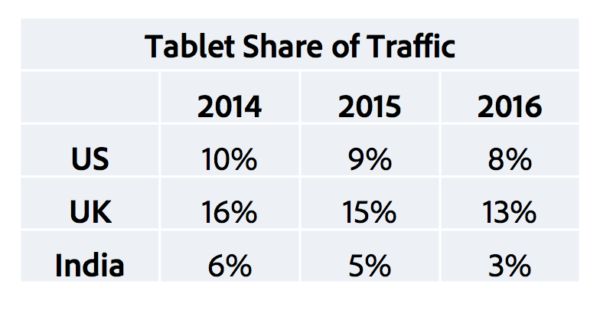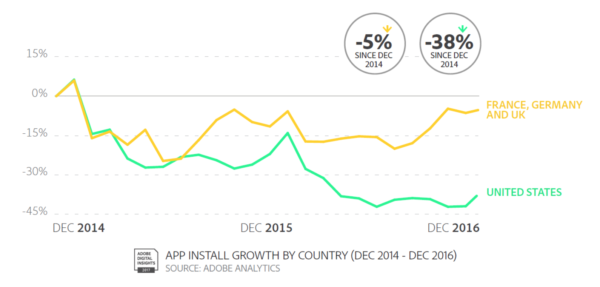Report: The PC is over, the “app boom” is too
Smartphones have grown at the expense of other devices, but most of the growth is now in developing markets, according to Adobe.

The desktop world is flat, but mobile app installs are down, too. That’s according to a new collection of internet usage stats from Adobe, released during the Mobile World Congress event going on now in Barcelona, Spain.
The report, containing a somewhat random collection of data, is based on “analysis of over 1.7 trillion visits to over 16,000 websites [and] over 130 billion app launches from over 1,000 apps.” Adobe argues it’s the “most comprehensive and accurate” in the industry.
Starting with a Black Friday recap, Adobe says that 2016 discounts were much steeper than in 2015. Some of this applied to tablets. However, despite the discounting, tablets have not come back in terms of consumer adoption and usage. Their share of traffic continues to decline.
 Adobe says that consumers are embracing AMP and that the top digital publishers are now seeing 7 percent of their traffic across devices from AMP. In addition, there has been more than 400 percent growth in AMP usage since 2014.
Adobe says that consumers are embracing AMP and that the top digital publishers are now seeing 7 percent of their traffic across devices from AMP. In addition, there has been more than 400 percent growth in AMP usage since 2014.
Back to the desktop, Adobe says that PC traffic has been flat to declining over the past three years. The implication is that there’s no growth to be had from the desktop, though specific companies or sites may defy that.
This is because of the rise of smartphones. The report says that smartphone-based web access has grown “at the expense of other devices”:
- Smartphone visits have grown 69 percent since 2014.
- Desktop and tablets both lost ground (down 23 percent and 19 percent since 2014, respectively).

At the same time, Adobe declares the “app boom is over” (in the US). The company says that app installs have declined almost 40 percent since December 2014. It counsels brands to focus on retention, not just acquisition — though that’s not a new insight.
The story is different in developing markets. Adobe says that smartphone growth is booming in those markets, with India, China and Brazil alone responsible for 400 million new smartphone users since 2014. Longer term, Adobe says that developing market trends should follow the US.
Yet what makes them different is that many developing markets are “mobile first,” since they don’t have a PC infrastructure. Those that do, however, are seeing similar traffic flattening or declines on the desktop.
Marketing Land – Internet Marketing News, Strategies & Tips
(44)













